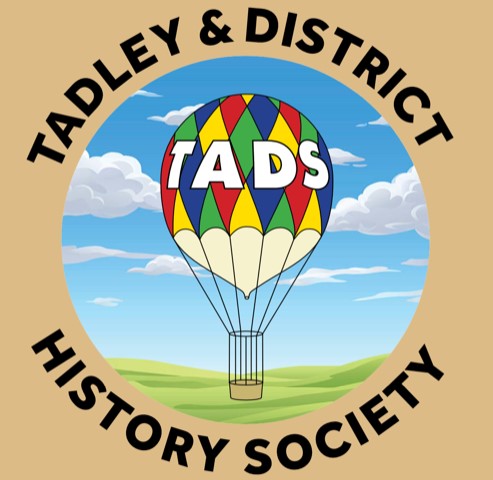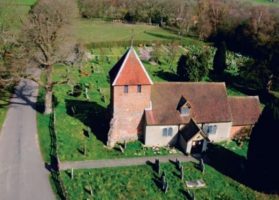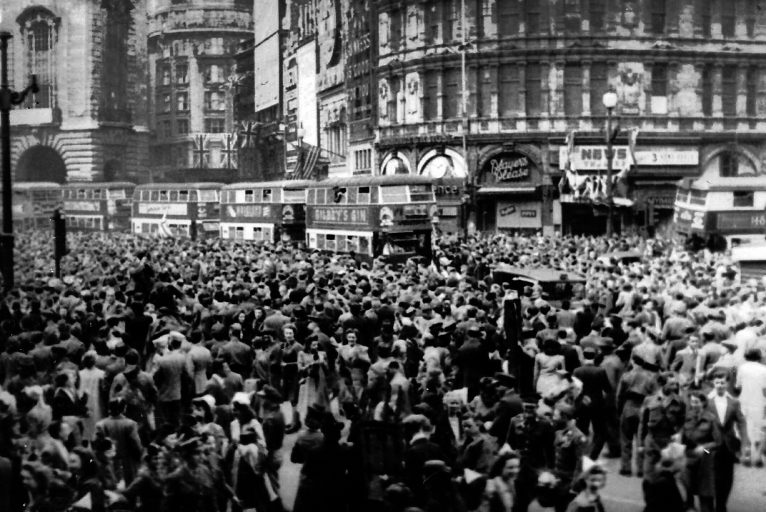The German unconditional surrender took place at Rheims at 2.41 am on Monday 7 May 1945 and was signed to take effect from midnight on Tuesday 8 May, the day that would become known as Victory in Europe, or VE Day.
The Prime Minister, Winston Churchill, made a broadcast on the wireless at 3.00 pm on the 8 May to this effect. His speech was relayed from the Town Hall in Basingstoke where a huge crowd had gathered to hear the news. It was followed with the sounding of ‘The Ceasefire’ by the band of HM Scots Guards.
The Mayor of Basingstoke then made a short speech in which he thanked The King and Queen and their family for their support during the hardships of war and asked the crowd for three cheers for the Royal Family.
This was followed by a service of Thanksgiving in the War Memorial Park where, yet again, a large crowd gathered for the service.
At 6.00 pm, once again the crowds gathered in Town Hall Square to await the broadcast of the King’s speech. The Mayor made a lengthy official address to the crowd followed at 9.00 pm by HM King George VI who made his personal broadcast to the Nation in which he announced that he wished the Sunday following VE Day to be observed as a day of thanksgiving and prayer.
Although unofficial news was received on 7 May that the Germans had surrendered, and that the day following VE day was to be a public holiday, it came too late for much decorating of streets and buildings and organising of events to take place. The Hants & Berks Gazette reported that despite this, the people of Basingstoke had worked into the early hours making and hanging bunting, flags and streamers to create a festive atmosphere in the town. Some outlying streets and villages even managed to organise teas and games for the children.
London officially celebrated victory on 8 June 1946 when Commonwealth, Empire and Allied Victory Celebrations were held. This consisted mainly of a military parade through the city which reached nearly four miles in length. It was followed by a fly-past of 300 aircraft, led by Douglas Bader, the wartime flying hero who despite losing his legs in a crash, continued flying.
After sunset the principal buildings of London were illuminated by floodlights and crowds thronged the banks of the Thames for a firework display and to watch as the Royal Family proceeded down the river in the Royal barge.
Local Victory celebrations were held, in the main, on Monday 10 June 1946, the Whit Monday Bank holiday. The Hants & Berks Gazette carried reports of most events in local villages, including Tadley, Pamber Heath, Silchester and Little London.
They were unfortunately marred by periods of heavy rain but Tadley remained positive and the report says ‘ … the weather held good, and a large number of people spent an enjoyable time’.
The event was held on what was then known as the Recreation Ground (The Green) and was organised jointly by the Memorial Hall committee in conjunction with the village Victory committee. The hall committee were anxious to raise funds for the recent proposal to build a hall in memory of those men who had died.
The proceedings began at the ‘Fox and Hounds’ from where the Tadley Prize Silver Band led the fancy dress parade down Mulfords Hill to The Green. During the afternoon there were sporting events, teas in the church hall and numerous side-shows. In the evening a dance was held in a large marquee.
The event added a substantial amount to the Memorial Hall fund.
The Pamber Heath celebrations were held in the field adjoining ‘The Pelican’ but the weather interrupted events and community singing took place when the rain was at its worst. In the evening a concert was held in a marquee.
Image: Piccadilly Square pictured as supporters celebrate VE Day, May 08, 1945. Photo taken by Sgt. James A. Spence, during his service in World War II.


